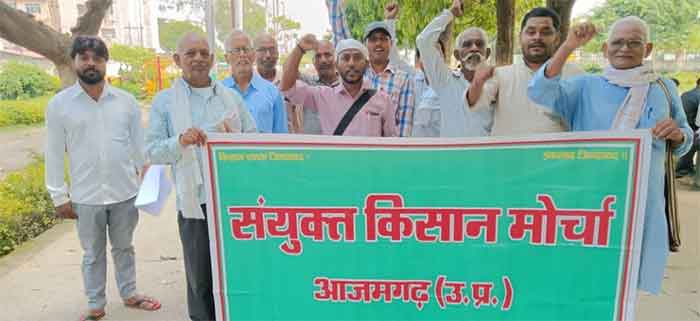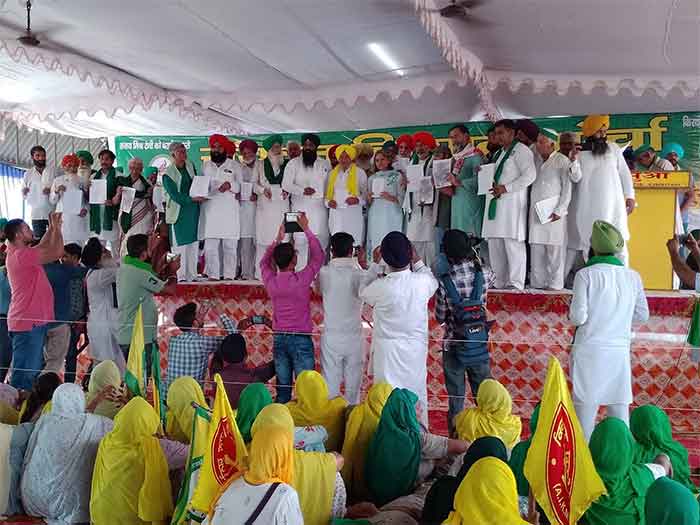
Lakhimpur Kheri, situated in the northern Terai region of Uttar Pradesh and bordering Nepal, has all of a sudden caught the attention of national political parties and media – due to the violent clashes there on October 3 during the demonstration of farmers agitating against three unpopular farm laws of the Modi government. The clashes resulted in the killing of eight people, including four farmers, a journalist, and three others, who are being claimed by the BJP as their followers .
Meanwhile, a well-researched and analytical article by Radhika Ramaseshan, entitled: ‘The Lakhimpur Kheri Incident Didn’t Occur by Chance, it was a Long Time Coming,’ which was circulated by the newsportal Vibes of India on October 5, has drawn our attention to the discontent that had been simmering among the sugar cane cultivators of Lakhimpur Kheri for quite some time, because of the non-payment of dues by sugar mills , for the sugar cane supplied to them by the farmers. In a bid to articulate their specific grievances and make their protest a part of the wider on-going national farmers’ agitation against the farm laws, they came out on the roads of Tikonia in Lakhimpur on October 3. They were assaulted by BJP workers , and a car of a BJP minister and his son was alleged to have mowed down a number of farmers. There are also allegations of the farmers lynching some BJP workers, in retaliation.
While condemning the unwarranted assault on the peaceful demonstration of farmers, Radhika Ramaseshan describes Lakhimpur as “…one of the less volatile parts of UP,” and enjoying a “phlegmatic disposition.” But let me set the records straight. Some half a century ago, Lakhimpur enjoyed the reputation of a `volatile’ district in the eyes of the then administration, and that also due to the same cause – protests by the farming community.
Let us go back to the troubled history of Lakhimpur Kheri and its surroundings. In the past, the area was covered with forests, and inhabited by the tribal Tharu people. Later, the Congress government of Uttar Pradesh invited the landless peasants from the eastern districts of the province (Gorakhpur, Deoria, Ballia, Azamgarh) to Lakhimpur to clear the forest land and plough there, promising them with acres of the land that they ploughed, for their own possession. As a result, the original Tharu inhabitants, driven out from their traditional forest habitations and deprived of the forest produce on which they depended, migrated to Nepal, where they hoped to eke out a living with the help of their co-tribal neighbours. Meanwhile, as for the new migrants from eastern UP, who cleared the forest land and made it cultivable, very few among them got the acres promised to them. Some of these new farm lands were captured by rich landlords from neighbouring areas through their connection with the ruling party, or by force. The migrant peasants were compelled to work as share-croppers or agricultural labourers for these landlords. Some other farms were handed over by the UP Congress government to industrialists, who invested in sugar cane cultivation – like the Birlas who set up the Oudh Sugar Mills in Pipra; the Bajaj group which came in possession of a 3,000 acres plot renamed as Jamnabad Farm; the Lakshmi Sugar Mills which attached the Khanjan Nagar Farm of 1,200 acres. (Re: C.K. Arora – NEW PASTURES FOR CPI, in the weekly `Frontier,’ Calcutta, November 15, 1969). This is how Lakhimpur evolved into what is known as the sugar bowl. (As a parenthesis, it is interesting to note that the sugar bowl continues to be dominated today by the same Bajaj industrial concerns , as evident from Radhika Ramaseshan’s article, where she mentions the Bajaj Hindusthan Sugar mill at Gola Gokarannath, and the Bajaj Hindusthan Sugar mill at Palia Kalan which are operating today in Lakhimpur).
To go back to the 1960s, Lakhimpur was left with a disgruntled farming community – victims of broken promises by the ruling powers. They articulated their grievances in sporadic demonstrations of protest, often under the auspices of non-Congress Opposition politicians who usually visited the area on the eve of elections, to attract their votes. The 1967 general elections brought these non-Congress politicians to power in UP, led by Charan Singh as the Chief Minister. But the Lakhimpur peasantry continued to suffer from depredations by landlords, who had in the meantime forged alliance with these new political rulers.
In the months of January and February of 1968, the peasants of Lakhimpur rallied around a political organization called the All India Co-ordination Committee of Communist Revolutionaries (AICCCR), which was formed by dissidents from within the CPI(M), in support of the 1967 Naxalbari uprising . The cadres of this organization mobilized the Lakhimpur peasants to re-occupy their lands. All through the months of May and June that year, there were pitched battles between the peasants and the hired goons of the landlords. The peasants were able to drive them out from farms in Patian, Ghola and Ibrahampuri , free those lands from the clutches of the oppressive landlords, cultivate them, and feel a sense of freedom during the months that followed. The movement spread further down from Lakhimpur to Bahraich and Sitapur. (Re: `Armed Peasant Struggle In The Palia Area of Lakhimpur’, in the journal Liberation, Calcutta. April. 1969). Incidentally, Sitapur is the place where recently Priyanka Gandhi was placed under temporary detention, when she tried to visit the families of the victims of the October 3 killing.
But for the peasants of Lakhimpur in the late 1960s, it was only a brief spell of freedom. From the beginning of 1969, the UP administration started taking steps to counter the peasants’ resistance. It deployed its para-military force, the Provincial Armed Constabulary (PAC) , which set up camps in the villages where these peasants lived, and carried out raids and arrested the activists. By April that year, the peasants’ movement in Lakhimpur seemed to have suffered a setback, as evident from the above quoted report, where the AICCCR organizers admitted that “after the police raids we went into passive defence.” They then decided on a new course of action – appealing to the peasants (who had been ousted from their lands by the PAC, and had been forced to return to the role of share-croppers) to “stop all payment of a share of the produce to the landlords and big farmers,” and “stop all payments of old debts to the money-lenders
The AICCCR’s new strategy however , failed to revive the movement. The peasants were subdued and suppressed by the UP government, which arrested their leaders. One of the arrested leaders was Vishwanath Tewari, who had endeared himself to the fighting peasants during the struggle. The government announced a prize on his head. He was arrested on charges of arson, loot and dacoity. (Frontier, November 15, 1969).
Although the peasant movement of Lakhimpur Kheri of 1968-69 was crushed by the ruling powers, its embers have been reignited today by a new generation of protestors.
Sumanta Banerjee is a political commentator and writer, is the author of In The Wake of Naxalbari’ (1980 and 2008); The Parlour and the Streets: Elite and Popular Culture in Nineteenth Century Calcutta (1989) and ‘Memoirs of Roads: Calcutta from Colonial Urbanization to Global Modernization.’ (2016).
















































